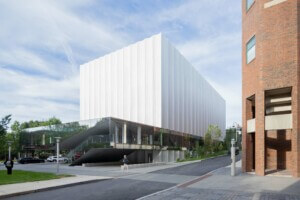According to Moving Together Providence has the potential to be a “world model for urban design.” That is of course, if the city decides to go ahead with their ambitious proposal of tearing up the 6/10 connector which joins Routes 6 and 10 between Olneyville and the interchange with Interstate 95, replacing it with a bicycle- and bus-friendly green boulevard.
Currently, the connector makes use of eleven bridges, nine of which are over 50 years old and are in need of repair. The Rhode Island Department of Transportation estimates that such restoration would cost upwards of $400 million.
Moving Together argues that instead of using those funds to fix infrastructure that will inevitably have be repaired again, the money should be used to transform the connector into a green boulevard with special bus and protected bike lanes. That’s something, Rhode Island Governor Gina Raimondo has said she would like to see take place.
Today, the connector heavily prioritizes private and commercial vehicle access into, out of, and through the city center. This has been the case for so long now, that the system has since become deeply embedded into Providence’s urban fabric. However, these outdated priorities may have to make way for the contemporary demand of more efficient transportation connections that address communal, environmental, and economic needs—the triple bottom line.
Naturally, there is a popular concern that removing such a widely used highway will only increase traffic. Nevertheless, urban planner Alex Krogh-Grabbe dispels these fears, saying that traffic is only increased as capacity is added, a concept known as “included demand” whereby people only use a service (in this case the highway) due to its presence. In taking away a travel option, routes into the city are actually diversified, with drivers taking many different journeys via local streets.
An example of this can be seen in New York City. In 1973, the West Side Highway was removed due to a partial collapse. At the time, some 80,000 vehicles used the highway daily. Officials were baffled when traffic in the surrounding neighborhoods didn’t increase with the elevated highway’s closure. Now that highway is a wide boulevard running alongside the Hudson River Greenway with a much used bike route.
Another dramatic transformation can be seen with the Cheonggyecheon Highway in South Korea. Here the removal of the much used highway saw a 600percent increase in biodiversity, a 35 percent drop in particulate pollution, and up to a 50 percent increase in land values within the vicinity.
Aside from the obvious health benefits, protected bike lanes bring economic reward, too. In New York City, local businesses on the 9th Avenue protected bike lane witnessed a 49 percent increase in retail sales (compared to the borough average of 3 percent). In terms of safety, studies have shown that such lanes can contribute to a 90 percent reduction in injuries per mile and as for reducing emissions, choosing to cycle to work can reduce household emissions by 6 percent—a viable options for half of the United States who live within 5 miles of their workplace.
Buses, too, can aid in this area. Dedicated lanes separate buses from general traffic allowing them a faster journey into the city unclogged with traffic, allowing them to carry many more people.
All in all, the scheme offers a progressive and viable alternative to the highway that now slices through the city. Whether Providence’s residents will take to the idea though, remains to be seen.










